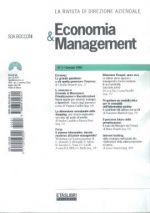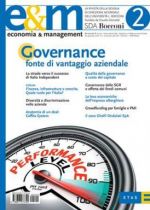Ricerca
Filtri applicati:
Raffina la ricerca
- Parola chiave
- Italia (5)
- Quotidiani (4)
- Digitale (2)
- Discriminazione di genere (2)
- Internet (2)
- Made in Italy (2)
- istruzione (2)
- povertà (2)
- Macroarea
- Contabilità e Controllo (12)
- Diritto (2)
- Società e cultura (2)
- Ambiente ed energia (1)
- Economia (1)
- ICT (1)
- Area di conoscenza
- Processi e istituzioni culturali (18)
- Economia, lavoro e organizzazioni (10)
- Politica sociale (2)
- Teorie sociologiche e trasformazioni sociali (2)
- Sociologia del territorio (1)
- Studi di genere (1)
- Vita quotidiana (1)
- Settore
- Media, informazione e comunicazione (6)
- Servizi (5)
- Enti non profit (2)
- Industrie della distribuzione (1)
- Istruzione, formazione e ricerca (1)
- Manifatture (1)
- Tipo contenuto
- Articolo di rivista (29)
- Editoriali & Opinioni (4)
- Intervista (2)
- Case History (1)
- Dossier e report (1)
- Lingua
- Italiano (7)
- Continente
- Europa (7)
- Asia (1)

L’esercito di riserva: femminizzazione e profitto nella professione legale inglese
Nella professione legale la segregazione orizzontale (divisione fra aree femminili e non) riproduce situazioni di stratificazione verticale, contribuendo a spiegare il ruolo prettamente salariato delle donne avvocato negli studi associati. Ciò comporta una polarizzazione netta fra aree di esercizio principalmente femminili, sottopagate e orientate alla soluzione di problemi di natura privata, e aree ...

La sicurezza dell’insicurezza: la nuova legge sul lavoro e gli impatti sul clima organizzativo
Le imprese hanno accolto con favore il Jobs Act, ma non è chiaro se abbiano, nel breve termine, valutato tutti gli impatti (positivi e negativi) e, nel lungo termine, preso in considerazione le ripercussioni sul clima aziendale.#

Progettare un modello etico per le comunità dell’information society. Il contributo del settore non profit
La mancanza di condivisione dei valori sui quali si fondano le comunità appare come un fattore di ostacolo al loro stesso sviluppo. Per questo, anche alla luce delle innovazioni portate dall’evoluzione dell’ information technology, diventa fondamentale una profonda riflessione in chiave neo-contrattualista sul rapporto tra teoria evolutiva e teoria delle scelte etiche. Questo approccio permette ...

Lavoro e istituzioni nel mercato globale del fast fashion
La globalizzazione economica e i vigorosi sforzi manageriali per minimizzare i costi del lavoro nel settore del fast fashion hanno avuto come conseguenze quelle di svalutare il lavoro dei dipendenti, di standardizzare i loro compiti, di una progressiva riduzione degli investimenti in formazione. Un’analisi comparativa tra gli Stati Uniti e l’Italia ha messo in luce come, nonostante le maggiori ...

Storie svantaggiate come eredità
La rete Caritas è un osservatorio privilegiato sul complesso mondo della povertà. Gli assistiti costituiscono un gruppo multidimensionale per profili anagrafici, estrazione sociale, livello culturale e occupazionale. Emergono nuove, allarmanti situazioni di povertà, soprattutto tra i minori, connotate da alcuni denominatori comuni da non sottovalutare: la povertà è un fenomeno che tende a tramandarsi ...

Il «regime di povertà» tutto italiano
Fenomeno in crescita a seguito delle due crisi epocali degli ultimi decenni (Lehman Brothers e pandemia da Covid-19) la povertà è un fenomeno che viene studiato secondo criteri variabili a seconda del contesto. L’incidenza è aumentata in misura più significativa nelle regioni e nei gruppi sociali che, già prima delle crisi, erano più a rischio di povertà: è il caso del Mezzogiorno, delle ...

La povertà educativa richiede scelte forti
La correlazione tra indigenza e povertà educativa è un dato consolidato e inconfutabile che caratterizza in maniera preoccupante le forme di povertà più diffuse nel nostro Paese. Save the Children ha stilato, nel 2014, l’Indice di Povertà Educativa che rappresenta una sorta di bussola per misurare il livello culturale dei minori in stato di povertà. È però oltremodo necessario, oggi, superare ...

Giovani e lavoro. Una questione cruciale
I redditi da lavoro, soprattutto tra i giovani, sono troppo bassi e/o intermittenti. L’occupazione professionale, quindi, non è più una garanzia rispetto al rischio di povertà. La riforma del Jobs Act del 2015 ha incrementato l’occupazione ma a scapito della sicurezza sociale dei lavoratori: lo spettro della disoccupazione e il percorso professionale costellato da carriere frammentate sono ...

Lavorare sodo e divertirsi… in un magazzino Amazon
All’interno dei magazzini di Amazon i progressi tecnologici, e le tecniche manageriali a essi collegati, mirano a tracciare ogni movimento dei lavoratori, misurando e disciplinando ogni loro movimento. La crescente preponderanza di meccanismi digitali che si nutrono di lavoratori significa che il magazzino desidera non solo il lavoro, ma anche i dati. I sistemi software alla base dell’inventario ...

Diversità e discriminazione nelle aziende in Italia. I risultati dell’indagine 2013
Happy: Come quando lavoravi da Harrison. Harrison stravedeva per te! E tu gli vai a fare quello scherzo di metterti a fischiare le canzonette nell’ascensore! Biff (contro Happy): Be’, perché? Se mi va di fischiare ogni tanto? Happy: Ma non si affida un lavoro di responsabilità a un buffone che fischia nell’ascensore! A. Miller, Morte di un commesso viaggiatore, Einaudi, ...